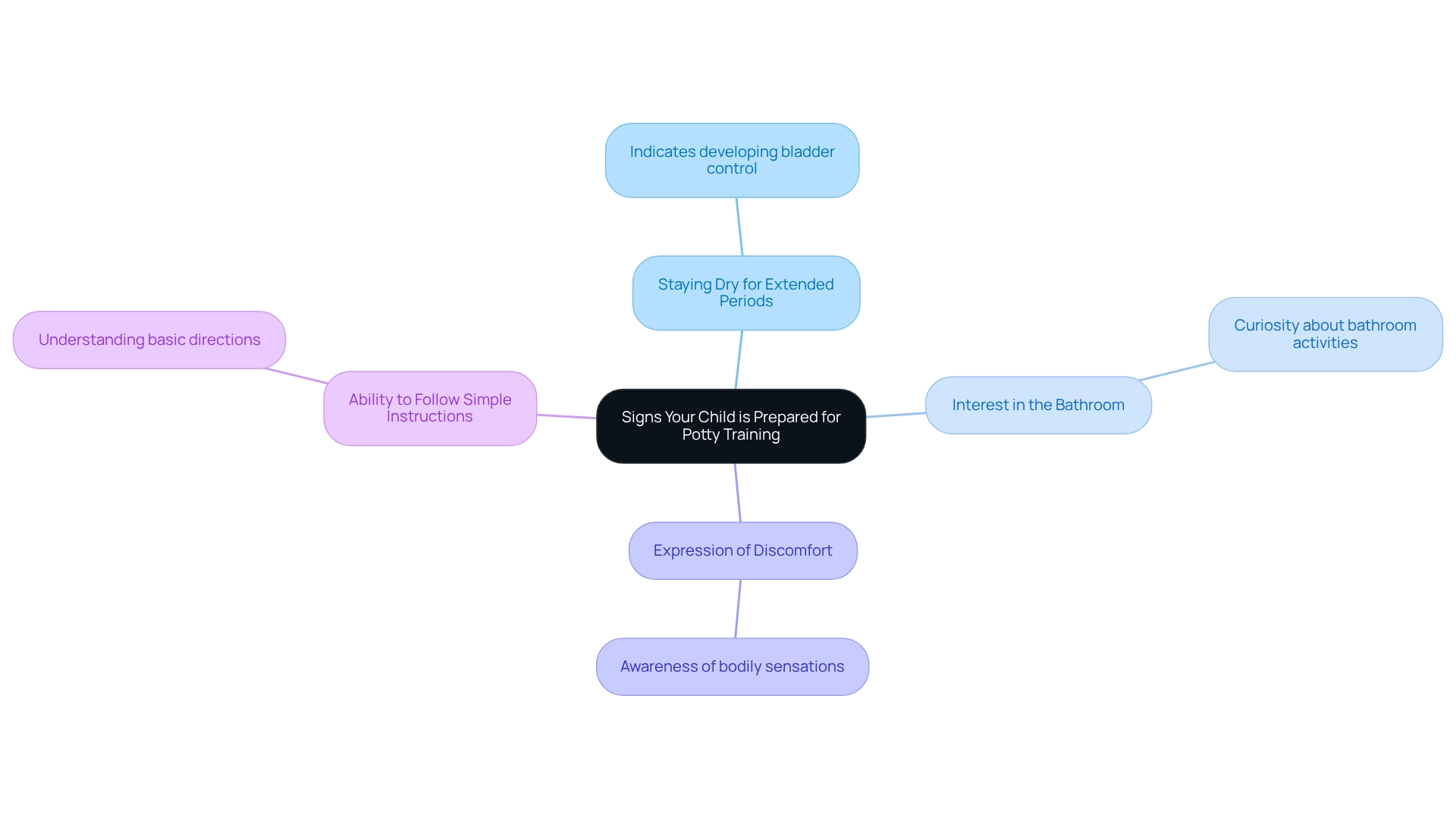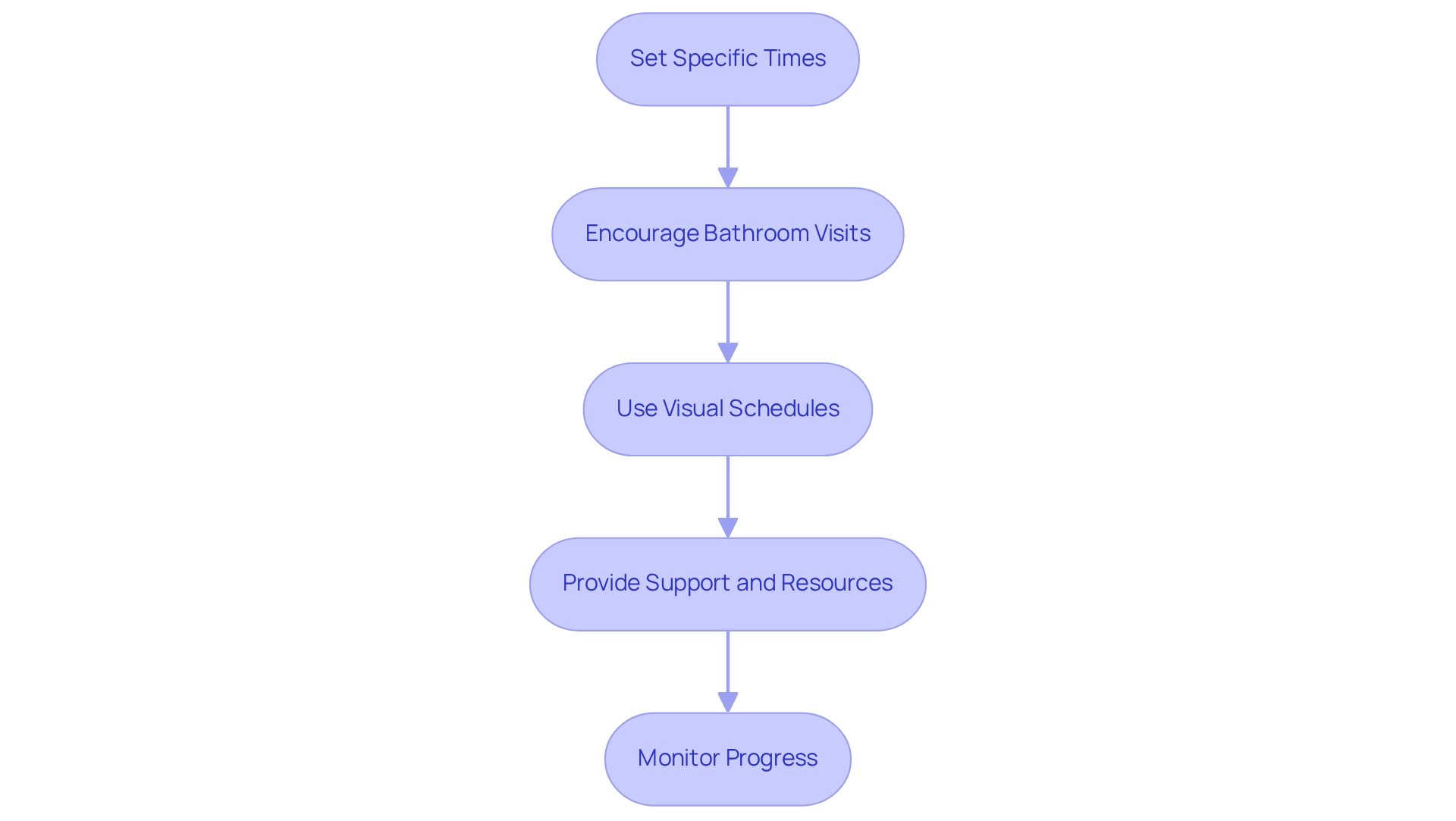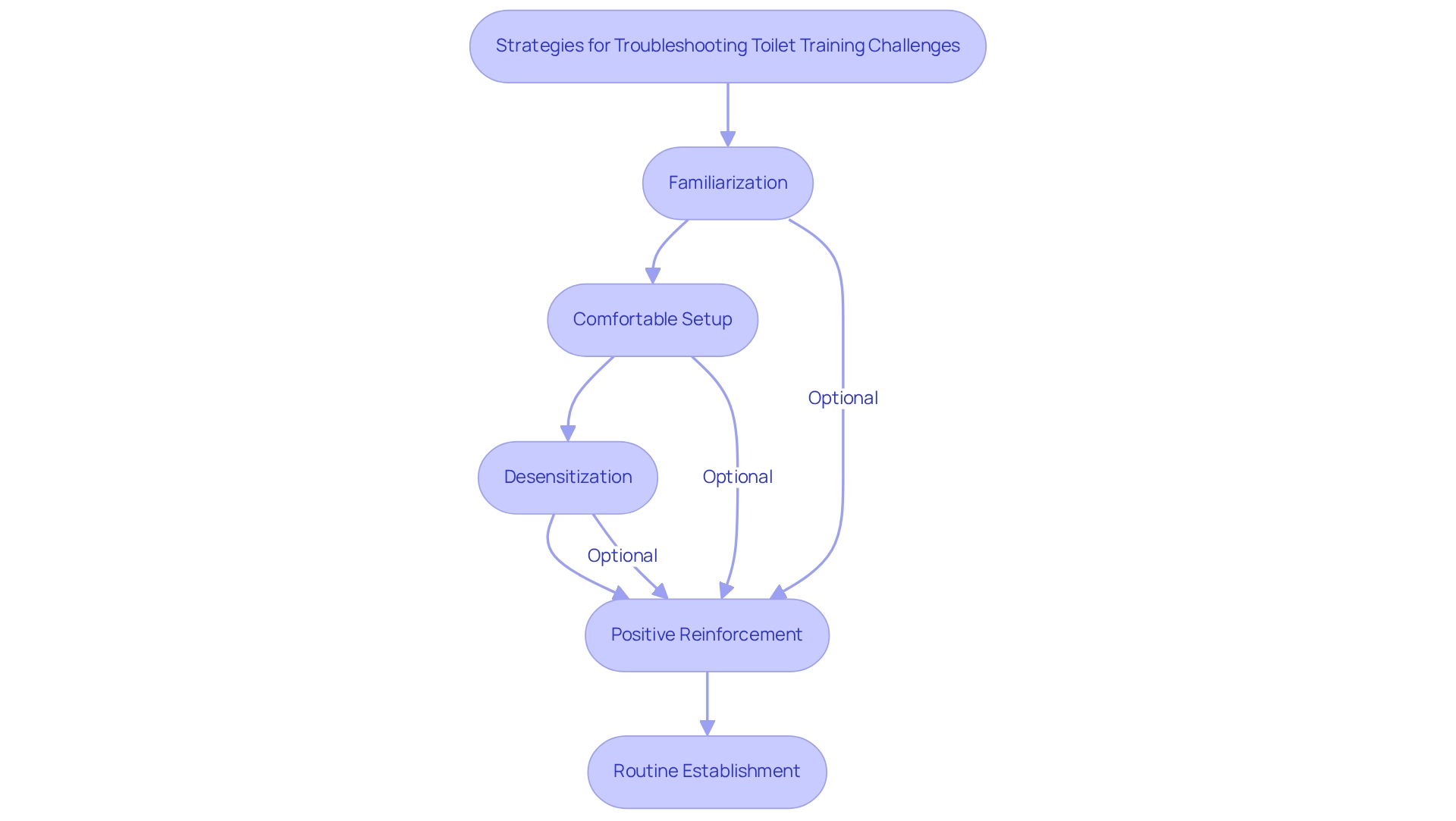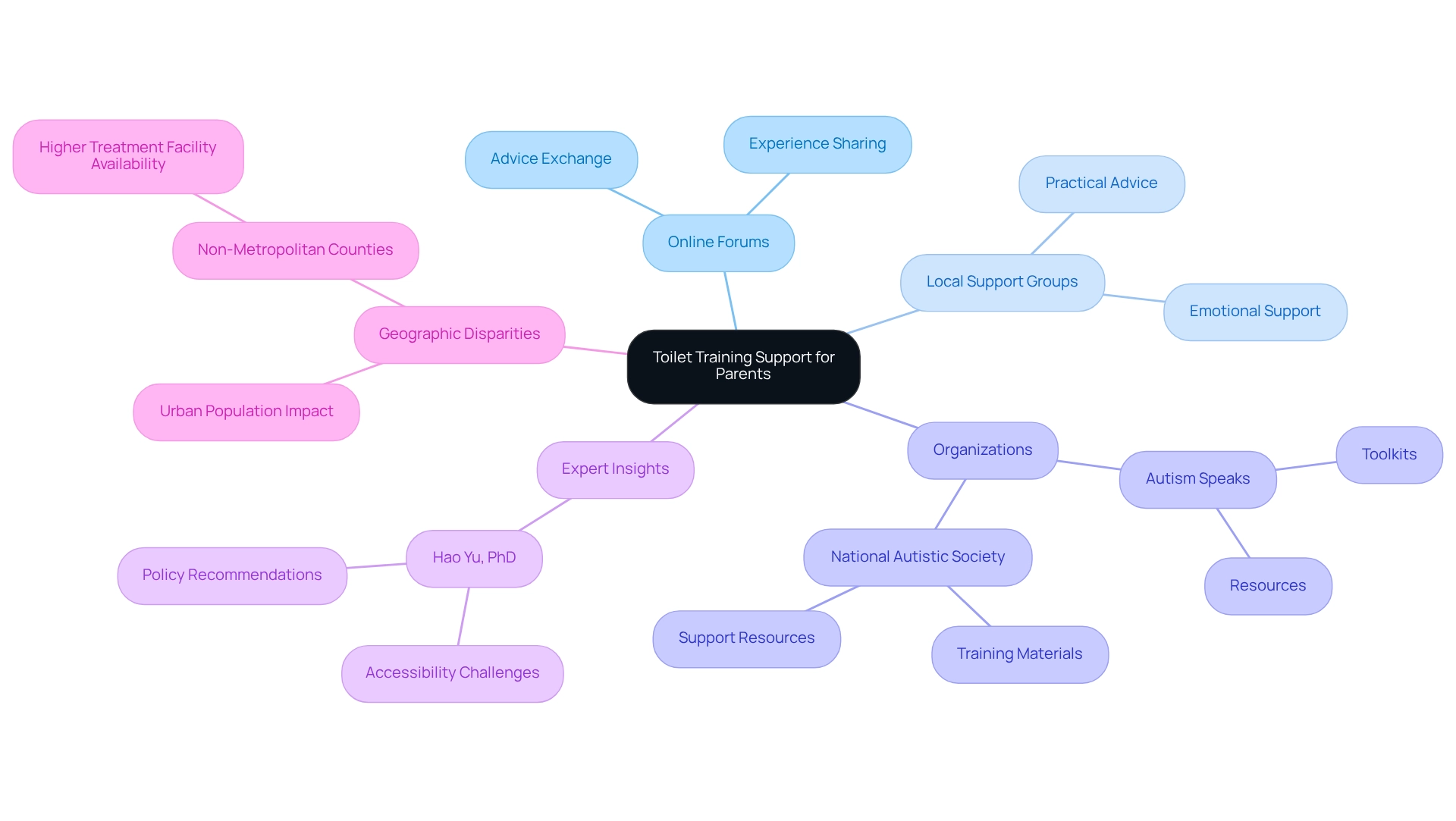Overview
Toilet training an autistic child can be a journey filled with unique challenges, requiring a personalized approach that truly understands their sensory sensitivities and communication hurdles. It’s essential to recognize that every child is different, and strategies should be tailored to meet their specific needs. Research highlights the importance of consistent routines and positive reinforcement, demonstrating that individualized plans can lead to successful outcomes in helping autistic children use the toilet independently.
As parents, you may find comfort in knowing that you are not alone in this process. Many families have navigated similar paths, and sharing experiences can provide valuable insights and encouragement. Consider implementing strategies that resonate with your child—whether it’s establishing a comforting routine or using rewards that motivate them. Each small step forward is a victory worth celebrating.
Ultimately, the goal is to foster independence and confidence in your child. By embracing a compassionate approach and seeking out resources tailored to your situation, you can create a supportive environment that encourages growth. Remember, your dedication and understanding are key to helping your child thrive during this important transition.
Introduction
Toilet training can feel like a daunting milestone for any parent. For those with autistic children, this journey often presents unique challenges that can be overwhelming. Sensory sensitivities, communication barriers, and the necessity for individualized strategies can complicate the process. Therefore, it is essential for caregivers to approach this task with patience and creativity.
Understanding the specific hurdles faced by each child is crucial. Tailored methods that cater to their distinct needs can make a significant difference. From recognizing readiness signs to utilizing visual supports and establishing consistent routines, a well-rounded approach can greatly enhance the likelihood of success.
This article delves into the multifaceted aspects of toilet training for autistic children. It offers practical insights and strategies designed to empower both parents and their little ones on this important developmental journey. We invite you to explore these strategies, share your experiences, and connect with others navigating this path together.
Understanding the Challenges of Toilet Training for Autistic Children
Toilet education presents unique challenges for autistic youth, particularly when it comes to helping an autistic child use the toilet due to various sensory sensitivities and communication hurdles. Many children on the autism spectrum may find the restroom environment overwhelming. The sound of flushing can be startling, and the sensation of cold seats may trigger discomfort or anxiety. Research indicates that sensory sensitivities are prevalent among autistic youth, significantly affecting their ability to engage in daily activities, including using the toilet.
Furthermore, communication barriers can complicate the process of teaching an autistic child to use the toilet. Autistic individuals often struggle to express their needs or discomfort, which can lead to frustration for both the child and their parents. This highlights the importance of recognizing each child's unique challenges and customizing the potty training approach accordingly.
Every child's experience with toilet training is different and may require tailored strategies for success. A case study titled 'Tailoring Strategies for Autistic Children' underscores the need for personalized potty training plans. By adapting strategies to meet each child's specific sensory needs and challenges, parents can create effective programs that enhance the likelihood of success, such as learning how to help an autistic child use the toilet.
As noted by experts in the field, setting a clear plan and consistently monitoring progress is crucial. Julie Stewart, a Field Development Coordinator for the KY Autism Education Center, emphasizes that the most vital step in teaching parents how to assist an autistic child in using the toilet is to develop a strategy, adhere to it consistently, and gather continuous data to evaluate its effectiveness.
Recent research published in the Journal of Autism and Developmental Disorders reinforces the necessity for tailored approaches. A comprehensive restroom education program was implemented with four elementary students with autism, resulting in all participants achieving mastery standards and maintaining independent use of the facilities. Notably, three of the children began self-initiating restroom use, illustrating the potential for success when strategies align with individual needs.
Understanding these factors is essential for crafting a supportive and effective restroom education strategy that empowers both caregivers and children in learning how to assist an autistic child in using the toilet. For those seeking further resources, an article PDF on this topic is available for £29.95, including VAT in the United Kingdom.
Recognizing Readiness: Signs Your Child is Prepared for Potty Training
Identifying when your child is ready for toilet training is a crucial first step in this journey. Look for the following signs that suggest your little one may be prepared to begin:
- Staying Dry for Extended Periods: If your child can stay dry for at least two hours during the day, it shows that their bladder control is developing, a key sign of physical readiness.
- Interest in the Bathroom: Notice if your child shows curiosity about the bathroom or mimics others using the restroom. This interest can be a powerful motivator for them to engage in the process.
- Expression of Discomfort: If your child can express discomfort when wet or soiled, it indicates an awareness of their bodily sensations, which is essential for successful bathroom training.
- Ability to Follow Simple Instructions: Your child should be able to understand and follow basic directions, such as 'let's go to the bathroom.' This skill is vital in guiding them through the process of using the restroom.
Research indicates that helping an autistic child with toilet training can be significantly improved by breaking the acclimatization process into smaller, manageable steps. By focusing on these readiness signs, parents can cultivate a nurturing environment that fosters confidence and success in learning to use the toilet. Involving fathers in this journey can be especially beneficial, as their participation often enhances the experience for young ones during this developmental phase.
For additional support, parents can download a visual aid for toileting, available in a PDF size of 111kb, which can serve as a valuable resource throughout the learning process. Understanding these indicators not only prepares parents for the path ahead but also empowers them to address their child's unique needs effectively. As one insightful saying suggests, "If you go sit over there I have a fun surprise for you," which can serve as a playful incentive during preparation.

Establishing a Consistent Routine for Successful Toilet Training
Establishing a consistent bathroom routine is vital for enhancing your child's comfort and success in learning how to use the toilet. Consider setting specific times throughout the day for bathroom visits, such as after meals or before bedtime. Research shows that when a structured approach is applied, children can self-initiate requests to use the toilet within just 7 to 11 training days, highlighting the power of a reliable routine.
Visual schedules can be a wonderful tool for helping your little one anticipate these designated times, making the routine more approachable and understandable. Consistency not only reinforces the desired behavior but also fosters a predictable environment, which is especially beneficial for children with autism. As Steven Zauderer wisely noted, "Finding the right assistance and access to a supportive community can make a significant difference."
Engaging with experts and connecting with supportive groups can further empower families, providing valuable knowledge and strategies for addressing bathroom habits. A case study titled 'Resources and Support for Bathroom Learning' illustrates how access to professional guidance and nurturing communities can greatly enhance the bathroom learning journey. By establishing a dependable schedule, you can cultivate a sense of safety and confidence in your child, ultimately leading to successful bathroom habits.

Utilizing Visual Supports and Clear Communication Techniques
Visual aids, such as picture schedules and social narratives, play a vital role in helping caregivers teach their autistic child how to use the toilet. By creating a visual chart that outlines each step—like pulling down pants, sitting on the commode, and flushing—you can provide a structured approach that enhances understanding. Utilizing simple language alongside clear visuals helps communicate expectations effectively, making the process feel less overwhelming for your child.
This method not only clarifies the steps involved but also alleviates anxiety by offering a predictable framework.
Research indicates that visual supports significantly improve the process of teaching an autistic child how to poop in the toilet. For instance, a resource designed for toddlers, which included engaging graphics, received overwhelmingly positive feedback, with 111 out of 132 reviews rating it five stars. This statistic highlights the effectiveness of visual aids in capturing young people's attention and assisting their understanding.
Experts stress the importance of customizing communication methods to address the distinct needs of every individual. As noted by Steven Zauderer, CEO & Founder of CrossRiverTherapy, 'Potty preparation for youngsters with autism involves understanding how to get an autistic child to poop in the toilet by customizing the methods to meet their specific requirements.' This underscores the significance of personalized approaches in developing bathroom habits.
Moreover, social stories have proven beneficial in teaching hygiene concepts, such as how to get an autistic child to poop in the toilet, by offering a narrative that children can follow, which further strengthens their comprehension and comfort with the process.
By integrating these strategies, you not only support your child’s learning but also foster a sense of independence and confidence as they navigate this important developmental milestone. For practical assistance, consider utilizing the FREE Wet/Dry Match & Sort Printable resource available, which can aid in pre-teaching activities related to bathroom habits. Tara's recognition with the Star of Excellence Award for her commitment to inspiring students further underscores the credibility of these strategies.
The Power of Positive Reinforcement: Encouraging Success in Toilet Training
Establishing a positive reinforcement system can significantly enhance your child's motivation during the bathroom learning process. Consider utilizing a variety of rewards, such as stickers, small toys, or additional playtime, to celebrate successful bathroom visits. For instance, a dinosaur-themed potty-training chart can visually track progress, rewarding each milestone with stickers that connect different dinosaurs along a fun path. This not only makes the process interesting but also offers a clear visual representation of accomplishments.
Celebrate every success, no matter how small, as this helps build your child's confidence and reinforces their efforts. Studies show that positive reinforcement techniques can greatly enhance toilet learning results, especially in how to help an autistic child learn to use the toilet. In fact, big-kid underwear can act as an enjoyable incentive for youngsters who have learned to use the potty, further motivating them to achieve.
As you progress, you can gradually lessen the physical rewards while still providing verbal praise, which is crucial for sustaining motivation and promoting ongoing success. Jenee Vickers Johnson observes that outcomes indicate the intensity of exercise will necessitate roughly 30-minute inter-sit intervals for six days a week, stressing the importance of a systematic approach.
Engaging specialists, like occupational therapists, is vital, as underscored in a case study that pointed out the lack of professional support as a major obstacle for caregivers. This organized assistance can improve the efficacy of instruction for children with autism, specifically addressing how to help an autistic child learn to use the toilet. Moreover, understanding how to assist an autistic child in this process while addressing potty learning regression and communication abilities can result in a more encouraging bathroom experience.
By nurturing a helpful atmosphere and employing these methods, you can establish a more positive and successful bathroom learning experience.

Troubleshooting Common Challenges in Toilet Training
Parents of autistic individuals often encounter unique challenges during toilet training, especially when it comes to encouraging an autistic child to poop in the toilet. This process can involve overcoming resistance to sitting on the toilet and addressing fears related to flushing. As highlighted in a review by Professor Jacqueline Roberts, navigating these hurdles necessitates a thoughtful and compassionate approach. To effectively troubleshoot these issues, consider implementing the following strategies:
- Familiarization: Gradually introduce your little one to the bathroom environment. Allow them to explore the space without any pressure, helping them become comfortable with the sights and sounds associated with the toilet.
- Comfortable Setup: Utilize a footstool or a specially designed potty seat to provide stability and comfort. This can assist your child in feeling more secure while sitting on the toilet.
- Desensitization: If your child displays reluctance, begin by having them sit on the commode fully dressed. This approach can help reduce anxiety and allow them to acclimate to the experience without the pressure of immediate expectations.
- Positive Reinforcement: Celebrate small successes to motivate your child. Use praise or rewards to reinforce positive behavior, making the process more enjoyable.
- Routine Establishment: Create a consistent bathroom routine. Regular bathroom visits can help your little one anticipate and prepare for the experience, ultimately lessening anxiety.
Statistics indicate that developmental disabilities affect a significant number of youngsters under five years old, underscoring the common challenges encountered during potty education. It is essential to approach these challenges with patience and creativity, particularly when considering how to get an autistic child to poop in the toilet. A one-day educational program focused on common toileting difficulties has been developed for professionals, equipping them with insights and techniques to assist families effectively.
This course aims to encourage autonomy and self-assurance in children, ultimately enhancing their bathroom skills experience. By utilizing these approaches, parents can navigate the challenges of bathroom learning and discover how to assist their child in achieving success in this area, paving their path toward greater independence. Moreover, it is crucial to acknowledge the concerns expressed by parents regarding the AAP's medical home model, which highlights the need for effective strategies and support in potty guidance for autistic individuals.

Embracing Patience and Flexibility: Navigating Setbacks in Toilet Training
Toilet training for autistic youth can often feel daunting, and the journey to help an autistic child use the toilet can be particularly challenging. Guardians frequently encounter setbacks, testing their patience and preparedness. Common toileting issues include:
- Urinating in inappropriate places
- Constipation
- Fears surrounding the process
This highlights the need for a patient and flexible approach when guiding an autistic child through toilet training. When faced with accidents or resistance, it’s crucial to pause and evaluate your current strategy.
Consider whether the routine may require adjustments or if your child could benefit from additional support. Research shows that typical sensory processing performance can significantly affect daily living skills, including toileting. For instance, a case study featuring two boys, Jim and Bob, illustrated that Jim's sensory processing difficulties led to significant challenges in self-care, while Bob's more organized sensory profile resulted in better bathroom habits.
This underscores the importance of tailoring strategies to meet each child's unique sensory needs.
Statistics reveal that 37% of parents resort to punishment, such as scolding, when faced with potty training challenges. However, this approach can exacerbate fears and anxieties related to toileting, especially in verbal children. Instead, creating a calm and supportive environment is essential for successfully guiding an autistic child through this process.
As Lisa A. Ruble noted, "We thank Susan K. Gray who helped with the survey questions, and Jan E. Hendrix who conducted the pilot study," highlighting the value of research-backed strategies in addressing these challenges. By maintaining a flexible mindset and adapting your methods, you can help your child learn to use the toilet at their own pace. Remember, each child is unique; what works for one may not work for another.
Expert opinions consistently emphasize that patience is not just a virtue but a fundamental element of this journey, allowing children to feel secure and understood as they acquire this essential skill.
Accessing Resources and Support for Parents During the Toilet Training Journey
Navigating the journey of helping an autistic child learn to use the toilet can feel overwhelming, but parents need not embark on this path alone. A wealth of resources is available to provide essential guidance and support. Engaging in online forums or local support groups can be incredibly helpful, allowing parents to share their experiences and learn from one another.
Organizations like Autism Speaks and the National Autistic Society offer tailored toolkits and resources specifically designed for toilet training. These materials can significantly boost parental confidence and provide effective strategies for assisting an autistic child in mastering this important skill.
Statistics reveal that fewer than half of mental health treatment centers across the U.S. offer behavioral health care services for youth with Autism Spectrum Disorder (ASD), highlighting a crucial gap in support. Notably, non-metropolitan counties with urban populations of 20,000 or more are more likely to have treatment facilities that cater to youth with ASD, indicating geographic disparities in access to vital resources. Despite these challenges, achieving success, including helping an autistic child learn to use the toilet, is within reach for many families. With the right support, parents can achieve positive outcomes.
Furthermore, expert insights underscore the importance of support groups in this process. These groups not only provide emotional support but also share practical advice on how to help an autistic child use the toilet, fostering successful bathroom habits. As Hao Yu, PhD, from Harvard Medical School notes, "Enhancing the accessibility of behavioral health care services at such establishments for youth with ASD is a challenge confronting policymakers at national, state, and county levels."
Case studies reveal that parents who actively participate in support networks experience higher success rates in potty training their children. This highlights the significant role of community involvement in the journey of helping an autistic child learn to use the toilet. By tapping into these resources and connections, parents can find effective ways to support their child's toilet training journey with greater ease and confidence.

Conclusion
Toilet training for autistic children is a complex journey, one that requires understanding, patience, and a tailored approach. This article has highlighted the unique challenges faced by these children, including sensory sensitivities and communication barriers. Recognizing readiness signs, establishing consistent routines, and utilizing visual supports are critical strategies that can significantly enhance the training experience. Each child is different, and adapting methods to their specific needs can lead to greater success.
Positive reinforcement is vital in motivating children during toilet training. Celebrating small victories and employing enjoyable rewards can help build confidence and encourage progress. Moreover, addressing common challenges with thoughtful strategies, such as familiarization and desensitization, can ease fears and resistance. It is essential for parents to embrace flexibility and patience as they navigate potential setbacks, understanding that each child's journey is unique.
Accessing resources and support can make a substantial difference. Engaging with community networks and utilizing available toolkits can empower parents and provide essential guidance. With the right strategies and support, successful toilet training is achievable, paving the way for greater independence and confidence in autistic children. By fostering a nurturing environment and remaining committed to individualized approaches, parents can help their children master this important life skill. We invite you to share your experiences and insights, as together, we can create a supportive community for all families navigating this important journey.
Frequently Asked Questions
What challenges do autistic youth face during toilet education?
Autistic youth may experience sensory sensitivities that make the restroom environment overwhelming, such as the sound of flushing being startling or cold seats causing discomfort. Additionally, communication barriers can complicate the process, as many autistic individuals struggle to express their needs or discomfort.
How can parents tailor potty training strategies for autistic children?
Parents should recognize each child's unique challenges and customize their potty training approach accordingly. Tailored strategies should address specific sensory needs and communication hurdles to enhance the likelihood of successful toilet training.
What is the importance of having a clear plan for toilet training?
Setting a clear plan and consistently monitoring progress is crucial in teaching an autistic child to use the toilet. Developing a strategy and gathering continuous data to evaluate its effectiveness are key steps recommended by experts.
What evidence supports the need for tailored approaches in toilet training for autistic children?
Research published in the Journal of Autism and Developmental Disorders shows that a comprehensive restroom education program led to all participants achieving mastery standards and maintaining independent use of facilities, demonstrating the effectiveness of tailored strategies.
How can parents identify if their child is ready for toilet training?
Signs of readiness include staying dry for extended periods, showing interest in the bathroom, expressing discomfort when wet or soiled, and the ability to follow simple instructions.
What role can fathers play in toilet training for autistic children?
Involving fathers in the toilet training process can enhance the experience for children, providing additional support and engagement during this developmental phase.
Are there resources available to assist parents in toilet training?
Yes, parents can access various resources, including a visual aid for toileting available as a PDF, which can serve as a valuable tool throughout the learning process. Additionally, an article PDF on this topic is available for purchase.




